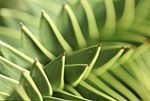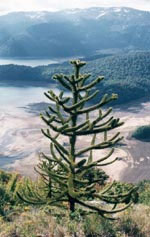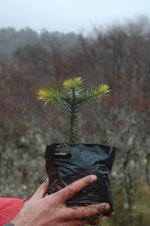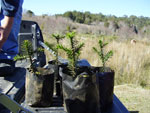|
MONKEY PUZZLE
Common Name: Monkey puzzle
Scientific Name: Araucaria araucana
Categories: Endangered; Sacred; National; Timber
Conservation Status: Vulnerable
National Tree of Chile.
Many people are familiar with the monkey puzzle tree. There is at least one in every botanical garden in Europe. This endemic evergreen conifer species grows naturally in temperate rainforests of south central Chile and adjacent areas in Argentina, reaching up to 2 m in diameter and 50 m in height, and may live for over 1,000 years.
Why is this species important?
A. araucana has great historical and social importance. The seeds form an important part of the Pehuenche indigenous people’s diet (Pehuenche means “people of Pehuén”, the local name for A. araucana). The tree forms characteristic forests, and is valued for its uniqueness and natural beauty, providing important tourism and recreational opportunities. For these reasons, it is the emblem of a number of national parks and provinces in both Chile and Argentina. Due to its high ornamental value, it is cultivated in gardens of Europe and America. A. araucana is also used to reconstruct climatic conditions by measuring the growth rings which may go back hundreds of years.
Where is it found?
A. araucana occurs in the Andean Range (37°S- 40°S) and the Cordillera de Nahuelbuta Coastal Range (37°S-38° S) of Chile and on the eastern slopes of the Argentinean Andes (38°S–39 S). It grows in mixed forests with deciduous or evergreen species (depending on the location), or in pure stands.
A. araucana forests are exposed to a disturbance regime characterized by recurrent volcanism and fire. Volcanic eruptions have caused burial of the land by thick volcanic lava flows. Natural fires started by lava and ejected incandescent material, as well as by lightning, are common in the area. Fires were also started by the aboriginal population prior to c. 1900, and later by European settlers and other groups, often associated with logging and seed collection activities. A. araucana establishes under the partial shade of post-fire stands dominated by Nothofagus species, or may be the initial colonist on rocky sites that have been burned. It has greater longevity compared with Nothofagus species, which is important for the persistence of A. araucana in these habitats.
How do people use it?
Between November and December female flowers start growing as spherical green cones formed by numerous coriaceous scales. Each cone releases between 120-200 seeds, called “piñones”, which are 4-5 cm long and 1.5 cm wide. These seeds are edible and form an important food source for the indigenous Pehuenche people in the central south of Chile. The seeds have a high carbohydrate content and the collection, storage, trade and preparation of meals from them is a characteristic and important part of the traditional lives of the Pehuenche people. Monkey puzzle wood has a high mechanical resistance and moderate resistance to fungal decay. These properties mean that it has been used for beams in buildings, bridges, piers, roofs, furniture, boat structures, veneers and plywood.
Why is it threatened?
A. araucana forests have been rapidly destroyed and degraded due to logging, fire and grazing. The declaration of the monkey puzzle tree as a Natural Monument in Chile means that logging of the species is now forbidden. The Natural Monument status was revoked in 1987, but it was reinstated in 1990 due to pressure from conservationists and indigenous people. However, there are currently pressures by some landowners to revoke the protection status once more, which would be a serious threat to the conservation of the species. During 2001-2002 thousands of hectares of native Araucaria forest were dramatically burnt in southern Chile. Preliminary information indicates that over 8,300 ha of native forest was burnt in the Malleco National Reserve, destroying 71 percent of the Araucaria araucana forests, and in Conguillio National Park 1,600 ha of pure Araucaria araucana forests were burnt. The cause of the fires is unknown but some local communities say that private owners were involved as they want to the 1990 logging ban to be revoked.
In Chile, national parks and reserves that protect the species are concentrated in the Andean ranges. In the Cordillera de Nahuelbuta (Chilean Coastal Range) most of the monkey puzzle forests are privately owned. Burning, grazing and conversion to Pinus radiata plantations have disturbed important areas in the Coastal Range, and these remain ongoing threats. New research has found that these coastal populations have genetic differences from those of the Andes, so their conservation is of great importance. The species is officially protected in Argentina and most populations are within national parks.
A. araucana is also listed in Appendix I of CITES, forbidding its international trade.
What conservation action is needed?
A conservation strategy for the species must consider the expansion of the Nahuelbuta National Park, and the development of new protected areas in the Coastal Range, especially in the southernmost populations. Restoration activities are also necessary for Andean and Coastal populations. Activities should include fine-scale mapping, in order to identify small-sized populations that require urgent restoration measures, and education on the conservation and propagation of A. araucana for local people. The Global Trees Campaign worked to restore A. araucana forest in Chile and Argentina and conducted educational programmes in two project between 2003 and 2007 (please see the project pages here for more information).
Selected references
Corporacion Nacional Forestal, Comision Nacional de Medio Ambiente, Universidad Austral de Chile, Pontificia Universidad Catolica de Chile, Universidad Catolica de Temuco (1999). Catastro y Evaluacion de los Recursos Vegetacionales Nativos de Chile. Informe final. CONAF-CONAMA, Santiago, Chile, 88pp.
Donoso, C. (1981). Tipos forestales de los bosques nativos de Chile. Investigacion y desarrollo forestal. Documento de trabajo N38. CONAF/FAO, 82 pp.
Donoso, C., Lara, A. and Alarcon, D. (2001). Araucaria araucana (Mol.) K.Koch, 1795. In: Enzyklopadie der Holzgewachse – 23. Erg.Lfg 3/01.Hoffman, A. (1991). Flora silvestre de Chile. Zona araucana. Segunda edicion. Edciones Fundacion Claudio Gay. Santiago. Chile. 258 p.
Veblen, T.; B. Burns; T. Kitzberger; A. Lara; R. Villalba. 1995. The ecology of the conifers of southern South America. In: Enright, N. & R. Hill (ed.). Ecology of the Southern Conifers, pp. 120-155. Melbourne University Press, Australia.
Local contacts
Institution: Universidad Austral de Chile (UACH):
Contact: Professor Dr. Antonio Lara
Email: [email protected]
Telephone: (56-63) 221228
Fax: (56-63) 221230
Institution: Universidad Catolica de Temuco (UCT)
Contact: Professor Mr. Marco Cortes
Email: [email protected]
Institution: Instituto de Tecnologia Agropecuaria (INTA)
Contact: Mr. Leonardo Gallo
Email: [email protected]
Telephone: (54- 2944) 422731
Back to Tree Profiles
|
CONSERVATION STATUS:
Vulnerable





|







